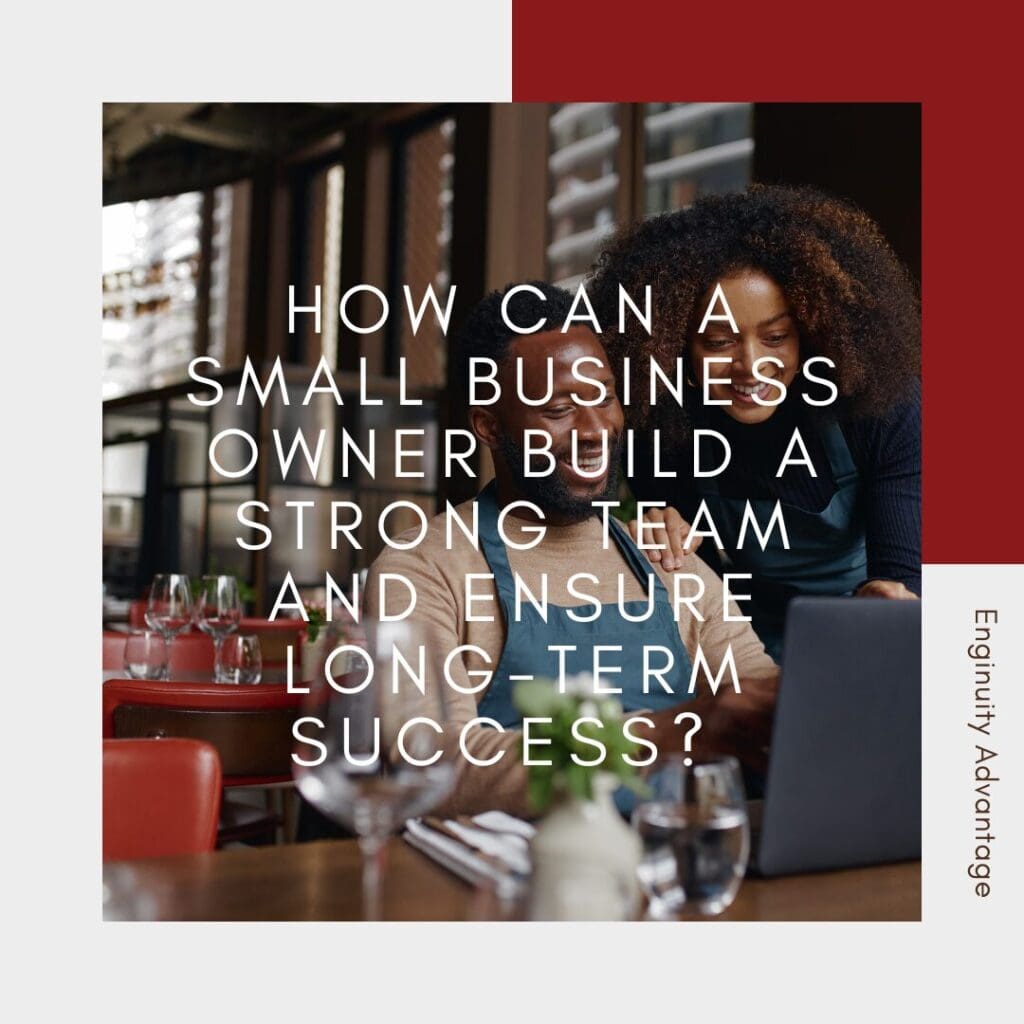How Can a Small Business Owner Build a Strong Team and Ensure Long-Term Success?

The Vision Behind a Lasting Team
The journey of building a resilient, high-performing team begins with clarity of vision. Small business owners are tasked with defining what their enterprise stands for, not just in terms of products or services, but in terms of values, purpose, and long-term goals. This vision isn’t meant to be a static document buried in a drawer, it must be alive in every conversation, hiring decision, and strategic move. When vision is aligned with day-to-day actions, it becomes a magnet for attracting individuals who believe in the same mission. Over time, this clarity creates cohesion and direction. Establishing a foundational mission also sets the tone for the kind of team culture you want to cultivate. Businesses that lack this level of clarity often struggle with turnover, disengagement, and misaligned performance because there’s no unifying principle anchoring the team.
When leaders define and reinforce company values consistently, they attract individuals who don’t just want a paycheck—they want to be a part of something. It’s that sense of shared purpose that allows a team to move in sync, anticipate one another’s needs, and pivot quickly when circumstances change. Whether it’s a two-person startup or a growing operation with multiple departments, the most successful small businesses operate with a collective sense of purpose. It becomes the framework for how the team interacts, innovates, and grows together.
Cultivating Talent That Aligns
Hiring is where your culture and vision are either reinforced or compromised. Each person you bring on board becomes a representative of your brand and an integral part of how your company functions. The recruitment process, then, must be deeply strategic. It’s not just about matching resumes to job descriptions; it’s about evaluating the whole person—their soft skills, values, long-term aspirations, and how they contribute to team dynamics. Hiring with intentionality avoids costly missteps and builds the kind of trust that is vital for team cohesion.
As your business grows, you’ll find that identifying the right roles and delegating accordingly becomes crucial. You can’t scale a company alone, and you shouldn’t try to. A great hire adds capacity, yes, but also creativity, accountability, and new perspectives. The goal is not simply to fill a seat but to fill a gap that, once closed, propels the business forward. It’s equally important to avoid the mistake of hiring reactively. Just because you’re busy doesn’t mean you need to add headcount. Strategic workforce planning considers the long-term vision and ensures each new hire is additive to your culture and mission.
Once you’ve built your team, retaining top talent requires just as much effort. And retention isn’t achieved by salary alone. The best employees stay because they feel valued, seen, and challenged. That’s why it’s essential to prioritize not just performance management, but also professional development and mentorship. Your people want to grow, and if you help facilitate that, they’ll often choose to grow with you.
This is where subtle resources, like the strategic hiring expertise of firms such as Enginuity Advantage, come into play. They offer small businesses a level of precision in talent acquisition that helps sidestep hiring pitfalls and accelerates growth without compromising quality.
Culture as the Engine of Success
Culture is more than catered lunches or occasional team-building retreats. It’s the invisible force that determines how people behave when no one is watching. In small businesses, where teams are lean and relationships are close, culture becomes even more influential. A toxic culture, left unchecked, will drive out good employees and repel potential candidates. A strong culture, on the other hand, becomes a competitive advantage.
Transparency, communication, and mutual respect are cornerstones of effective team culture. But these values don’t emerge by accident. They must be modeled from the top. Leaders who communicate clearly and frequently, who make space for feedback, and who celebrate achievements set a tone that permeates the rest of the organization. Culture is communicated not only through what leadership says, but through what it rewards, tolerates, and prioritizes.
Equally critical is creating a culture of accountability. It’s easy for a team to become siloed or unfocused if there’s no mechanism for measuring results and aligning performance with goals. Yet accountability doesn’t have to mean micromanagement. When employees understand the “why” behind their tasks and see how their work connects to broader goals, they begin to hold themselves accountable. Empowering your team to take ownership of their roles leads to greater engagement and better outcomes.
Recognition also plays a significant role in building morale. Simple acknowledgments, a shoutout during meetings, a handwritten note, or internal spotlights—can significantly boost employee satisfaction and motivation. Culture doesn’t need to be expensive or extravagant to be effective. What it does need is consistency and authenticity.
Investing in People and Systems
Training and development are essential for any team striving for long-term success. As industries shift and customer expectations evolve, businesses that fail to invest in upskilling their teams fall behind. Training should not be reserved for new hires alone, it must be ongoing and adaptive. Whether it’s cross-functional workshops, online learning platforms, or peer mentoring, continuous education ensures your team remains sharp and adaptable.
But developing your people goes beyond just offering courses. It means creating an environment where learning is encouraged, mistakes are viewed as opportunities, and curiosity is welcomed. When employees know they have room to grow and are supported in doing so, they stay longer and perform better.
To support this kind of growth, your business must also invest in systems that scale. As team size and complexity increase, so does the need for structure. That doesn’t mean bureaucracy, it means clarity. Project management platforms, standard operating procedures, and defined communication channels reduce ambiguity and improve efficiency. The more structured your business is, the more space your team has to innovate.
Small businesses often hesitate to invest in infrastructure, fearing costs or loss of flexibility. But the truth is, that scalable systems actually create freedom. They reduce decision fatigue, eliminate redundancy, and allow leaders to focus on strategic growth instead of daily firefighting.
Nurturing Collaboration Across Teams
True teamwork doesn’t end at individual performance, it expands into how teams function together across departments or project groups. In smaller companies, collaboration must be intentional because roles can overlap and responsibilities are often fluid. Leaders need to encourage cross-functional teamwork by setting shared objectives, facilitating open dialogue, and providing tools that streamline communication.
Conflict, when it arises, should be seen as a chance to refine processes and strengthen relationships rather than as a roadblock. Team-building exercises, while often overlooked, can bring long-term cohesion when tailored to your company’s environment. Virtual or in-person, shared experiences promote trust and understanding, especially when your team is geographically distributed or hybrid.
The more collaboration becomes the norm, the easier it becomes for the business to innovate, pivot, and thrive. It’s not about creating a workplace where everyone agrees, it’s about creating a space where diverse ideas are welcomed and molded into solutions that serve the greater mission.
Adapting with Resilience in Mind
Adaptability is a business asset. Markets shift, consumer behavior evolves, and technology continuously transforms the landscape. Resilience is the thread that ties together every aspect of team development. Building resilience starts with hiring flexible thinkers, but it continues through leadership modeling, resource availability, and psychological safety.
When your team feels supported during uncertain times, they’re more likely to stay engaged and offer innovative solutions. Resilience is also built through iteration. Allowing teams to test, fail, learn, and improve builds mental toughness and encourages long-term thinking. Without a mindset oriented toward growth, it’s easy for even the most well-built teams to become stagnant or resistant to change.
Leaders must cultivate this by reinforcing adaptability as a strength. Recognizing progress, not just results, helps teams see the value in the journey, not just the outcome. Whether it’s navigating a new competitive threat or pivoting during a supply chain disruption, resilient teams become a company’s greatest asset.
Encouraging Innovation from Within
Innovation doesn’t always mean radical change, it often begins with empowering employees to challenge assumptions, test new ideas, and bring fresh thinking to everyday processes. Small business owners who create an atmosphere where creativity is rewarded, not penalized, can unlock powerful solutions from within their team. This means allowing room for experimentation and reframing failure as part of the learning curve.
Encouraging team members to voice ideas, lead mini-projects, or explore new technology tools builds a culture of ownership. These contributions not only drive business improvements but also strengthen engagement and loyalty. When employees feel their ideas matter, they invest more deeply in the outcome. As innovation becomes embedded in the workplace culture, teams become more agile, proactive, and aligned with long-term growth.
Strengthening Emotional Intelligence and Team Dynamics
The emotional fabric of a team is just as important as the technical one. Emotional intelligence (EQ), the ability to understand, manage, and navigate emotions, plays a significant role in fostering collaboration and managing stress. When leaders and employees demonstrate high EQ, they build trust faster, resolve conflicts constructively, and maintain resilience through challenges.
Small business owners can cultivate this by promoting empathy, active listening, and emotional regulation through leadership development and communication workshops. Team dynamics improve when members are not only technically capable but also emotionally attuned to one another. This reduces misunderstandings, improves morale, and fosters a psychologically safe environment where people feel comfortable speaking up. A team that connects emotionally works better together, especially when the pressure’s on.
Aligning Growth with Purpose
As businesses scale, it’s easy to get caught up in expansion for its own sake. However sustainable growth should always be in service of a larger purpose. When team members understand how their daily work contributes to something meaningful, whether it’s making a difference in the community, advancing an industry, or simply creating exceptional customer experiences, they’re more motivated to stay the course.
Purpose creates cohesion. It ensures that growth doesn’t dilute your culture, but rather reinforces it. It also helps businesses attract purpose-driven talent, who increasingly seek employers with values that mirror their own. Aligning operations, communication, and performance metrics with that bigger “why” provides direction in moments of uncertainty. And in a marketplace full of options, purpose is often what keeps great employees, and customers, coming back.
Building for the Long Game
Sustainability in business isn’t just about financial performance, it’s about building an ecosystem where people, processes, and purpose align over time. Long-term success requires strategic patience, the willingness to course-correct, and the discipline to make incremental improvements every day. While short-term wins are exciting, it’s the enduring foundation of a great team that allows a business to scale and thrive for years to come.
To build for the long game, small business owners must regularly assess and adapt their team structure, strategy, and goals. Conducting periodic performance reviews, team feedback sessions, and strategic planning retreats helps realign the business with evolving market conditions. These practices are not just about evaluation, they’re about transformation.
One often overlooked aspect of sustainable success is knowing when to bring in external support. As the business grows, internal bandwidth may become limited. Partnering with trusted experts, especially for highly specialized needs like technical recruiting, can inject new energy and expertise into your operation. Organizations like Enginuity Advantage help fill those gaps with precision, giving small business owners the edge they need without derailing internal focus.
Ultimately, a strong team is a living, breathing entity. It requires nurturing, investment, and adaptation. The businesses that endure are not those that had perfect plans from day one, but those that committed to building and rebuilding their teams with intention and care. It’s a journey, not a destination. But for those willing to walk that path with integrity and vision, the rewards are far-reaching, not just in business growth, but in the lives impacted along the way.
Unlock Dream Careers & Elite Talent: Just One Click Away!


